Project 8 'Letters to Language',
Solo Exhibition, Cornerhouse, Manchester 1996
'‘Letters
to Language: Dear Missing’
Foreword
Pete
Clarke is an artist who combines images of the urban landscape
with fragments of text which can or cannot be connected
to the painted image. There is a perversity of the delight
of using painted language juxtaposed with the freedom and
openness which Clarke employs on his canvas through the
use of texture and colour. Clarke alerts us (as does James
Joyce) that language is as gestural and transformative as
the physical stuff of oil paint on canvas.
Clarke's
dialogue with the spectator is not however played out in
a polemical way, his pragmaticism is displayed through the
physical properties of the surface which show a considered
process of intensive making over many months.
'Letters
to Language' has a materiality about it that brings art
back from the abyss of the super information highway. Clarke's
paintings transmit a personal and intensive flow of communication
but it is a dialogue that each spectator comes to in their
own time not by the press of a keyboard but through the
emotions of quiet reflective contemplation.
Stephen
Snoddy
Curator
In
Praise of Slow Communication
By
Sean Cubitt
Greenbank
Road Studio installation on 'Capital' 26 interrelated paintings
1992 -1996
The
business, the busyness, the industry, the financial glyphs,
the race of colour. fragmentation and oblique brushstrokes
that since the futurists have been the breathless iconography
of speed, the dromocratic hegemony of the 20th century's
modern: you want, in an impossible search for translation,
to list methods and motifs in hurtling, punctuated sentences
as fractured as these composite canvases. But to add prose
percussion to the fast surfaces of the Letters to Language
would be to promulgate a profound misunderstanding, that
comprehension can be undertaken at speeds greater than the
processes of making. James Joyce once asked his readers
to take as long to read the Wake as he did writing it. (Perhaps
half a dozen crazed academics have done just that. A certain
sense of proportion is necessary after all).
'Capital'
Series Hope I X I V I U / Guilt
Capital'
Series Hope
Joyce's
remaking of the medium of language, as a medium, and as
the medium of thought and fantasy, the intimate medium,
is one pole of a modernism whose other cryptic extreme is
the utterly external analytic of the medium undertaken in
Duchamp's Large Glass, one of whose titles is Delay in Glass.
That delay has something to do with the slowness of glass
plate photography, the minutes of stasis required of those
Victorians, posed in deep thought among unmoving sunlit
graves, that Walter Benjamin describes.
'Capital'
Series Belief
'Capital' Series Guilt
And the lazy relay of the fall of light on some distant
afternoon delayed a century or more until we come to look
at its effect. The delay, most of all, that might occur
as, passing through the galleries, you stop, intrigued,
to allow one work to work as you work, tracing the fractal
gravure of that old light.
Not New
: Not Changed 1994
‘Changed:
Not New’ 1999
In
Pete Clarke's canvases, such delays occur, between the intimacies
of Anna Livia Plurabelle and the cold edge of words, the
ontological refractions of the Large Glass and the psychomorphisms
of The Bride Stripped Bare. Iconography, technique, composition
and installation, the categories of canonical analysis and
post structural interests in the materiality of art, meld
upon the single ground of the choice of paint, which is
no longer a simple, neither categorical nor a cure. But
it is, as Clarke practices it, work of and in representation
which unpicks the obsessive speed of both technological
media and their commentators, a considered art of consideration,
a lethargic mulling through the Süt?,wein of picturing,
in which Lethe's considerate waters wash the viewer's, as
the painter's, responses of their habitual accretions, standing
pictorial evocations over against the immediacy of media
that seek invisibility.
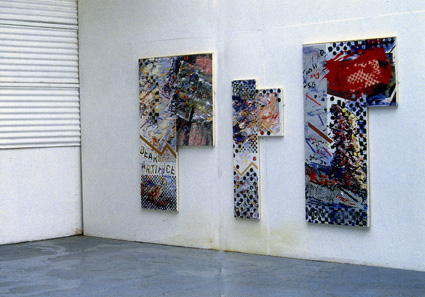 |
'Letters
to Language Installation : Code names 3 Month Gallery, Liverpool
1996
The
Letters, first, are letters, typographics, fonts, calligraphies,
themselves composed, discomposed and recomposed as print,
stencil, découpage, collage letters restored to the
chill air of denatured abstraction even as they fall from
the insensate grace of reason to private symbol and the
irredeemable personality of the hand. Like a child learning
that b is a fat boy hiding behind a wall, the letters which
painting sends back to language are at the same time the
minions of the information economy and the brute and unresolvable
forms of a dyslexic pictography whose every phase and phase
transition slows down transmission, until the medium challenges
the message.
'Letters
to Language' 'Dear Artifice' 1995 (detail)
Few
digital artists are as profoundly influenced in their work
by the materiality of informatics
as Clarke is in this obsolete praxis. Painting is important
today becauseit
is dead. To protest the death of painting is as futile as
protesting the death of God. But in its afterlife, painting
attains the critical delay which, in separating it from
the urgent quotidian, turns it into the ghostly ancestor
that haunts the hypermodern feast. Like Tiresias, this shade
that has been everything and now is nothing brings the sharpened
edge of prophecy to visual politics.
Today, in the era of vision's triumph, the politics of vision
has fallen victim to its own haste.
 |
'‘Letters
to Language: Dear Memory’
No longer a matter of representation, Western visual culture
has become the terrain of symbolisation, of graphemes isolated
from their discourses, pictures separated from what they depict
by the very speed of their circulation. The relation between
world, medium and audience has been cauterised in the substitution
of information for world, and transmission for mediation,
to create the isolation of the modern consumer. The works
in both Capital and Letters to Language become the slow harbingers
of a vacuum at the heart of semantic functionality. They are
not works about the collapse of meaning, but about the vacuity
of this vacuum: the difficulty of meaning under a triumphal
capitalism that seeks to erase it under the fetishised commodity
form, as utility and as exchange. The work of Clarke's canvases
is to rediscover meaning as that relationship between people
which, as Marx has it, appears to them as a relation between
things.
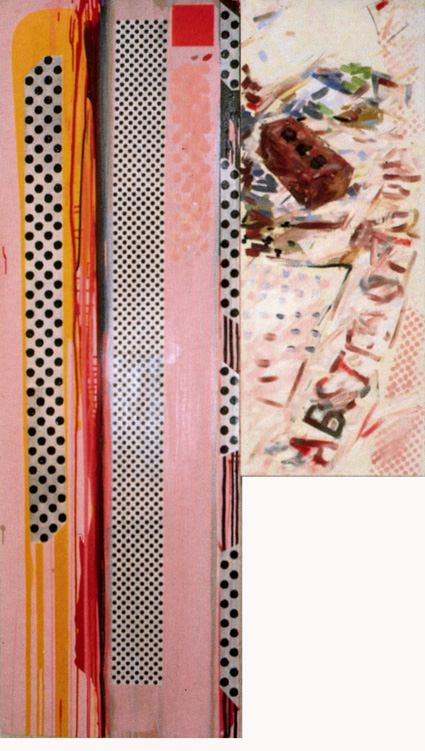 |
'Letters
to Language' 'Dear Abstraction' 1996
The
uncritical accolades for intertextuality that litter art
and cultural criticism over the last 30 years misunderstand
the processes of capital: the intertextuality of the Sunday
colour supplements is precisely a relationship between media,
as objects: not people, not subjects. Like the Dionysian
terror that haunts the Apollonian iconography of Poussin's
Landscape with the Ashes of Phocion, migrated from Liverpool's
Walker Gallery to the composition of Dear Memory, the violence
done in the name of King Cash underwrites the classical
architectures of banks, the geometric purity of fiscal graphs.
But where Victorian modernity clung to the icons of stability,
the accelerated demands of globalised info capital celebrate
the stasis of the whirlwind, the mocking zen of the strange
attractor. Capital need no longer fear Marx's piercing analysis
of 'all that is solid melts into the air': it has made change
and velocity its own heraldic devices. Everyone sees the
whizzing images: no one notes the still frame of the TV
screen.
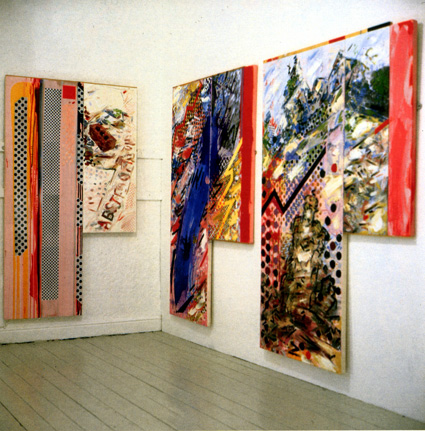 |
''Letters
to Language' Greenbank Road Studio Installation 1996
These
paintings do not abandon meaning, value or reason. With
the use of serial techniques like screen printing and èolour
photos, Clarke addresses the fall of passion into its signifiers
as analytically as his bravura paint handling, not the expression
of inner turmoil, but an investigation of what it means
to make that passionate engagement conform to a lexicon
of formalised techniques. We know that the expressionist
move in modern painting has always come up against the formalisation
of its classic gestures, just as Hollywood's stars give
us the common vocabulary of lust and anger from a database
of grimaces and tics as familiar as the alphabet. We know
too that the fragmentation of vision among the impressionists
became the foundation of mechanical vision, from colour
photography to satellite surveillance. The 20th century
history of graphic design is a prolonged attempt to recover
from the isolation of letters on the typewriter keyboard;
of cinema to anchor the autonomy of the human in the autonomy
of the machine; of science to rationalise the inhuman. Our
epoch is one swaying drunkenly between reason and madness,
two halves torn apart in the administrative logic of an
economy that still requires the fury of invention for its
survival.
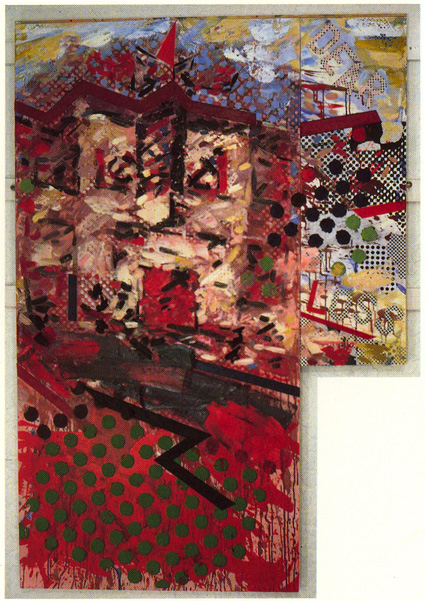 |
'Letters
to Language' 'Dear Loss' 1996
If,
as John Roberts argues, painting is peculiarly suited to
carrying out work on history, Clarke is a painter. The point
of the work is not to urge a reconciliation between rationality
and passion the undertaking of Matisse, uniquely the most
typical of modern painters but to understand the histories
of their divorce. Take the motif of the folly in these works.
Architecture is supposedly the art of space, abstracting
from the sheer dimensionality of the world forms for habitation.
Yet most architecture, quite apart from its apparent ignorance
of time, administers the rigourously managed spaces of Cartesian
geometry. Only the folly, purposeless it seems, serves not
only as the antiphonal descant to architecture's reason,
but as the persistence of another mode of thought, the critical
modernity of Erasmus' Praise of Folly, whose satire modulates
into celebration of Christ's folly in dying on the Cross:
the folly of redemption. The monument builder, as engineer
of madness, is the type of the artist, caught in the stupidity
of trying to construct a critique of commodity communication
within a commodity form, like the supernatural in a mortal
body.
Clarke's
pragmatism is as much a matter of the making of the work
as it is of its ostensible content. The canvases are worked
as surfaces and as labour and urge a recognition of that
work which mass culture denigrates in its entertainments
and its assumption of the pose of effortlessness. So, for
example, the 'expressive' brushwork not only functions as
critique of expression, but returns as a meditation on the
artisanal, the traces of a making which continues over months
and is abandoned rather than completed. The alphabet of
Capital is such a project of incompletion, not as resistance
to or subversion of the dominant mode of communication,
but as an alternative circulation, its difference derived
from the internal differences of language as alphabet and
as speech, but pledged to a conception of communication,
even of communion, which is excluded from the commodity
form.
The
Letters to Language face a different problem, metaphorically
the problem of the missing address: where should these letters
be sent? The paintings' legends give us Clarke's pro tem
solution: Dear Memory, Dear Loss, Dear Deficit, Dear Artifice,
Dear Monochrome, Dear Missing, Dear Shadow, Dear Abstraction...
In the delay between painting and language, and from the
perspective of painting, language, as information and transmission,
is a process which historically has removed itself from
a materiality to which painting might lure it back. Abstraction
is not a point of origin, but a labour in which you remove
the trappings of the actual in favour of the stable shape
of the ideal. But that ideal increasingly resembles the
commodity itself, gradually stripped of use to approximate
the final signified of contemporary capital, total consumption,
without object or subject. The testimony of this impossible
abstraction, the lure of the reconciliation of individual
and world in their mutual annihilation, gives Clarke his
addresses. The serial form itself mimics the industrialisation
of communication only to unpick its internal dialectic of
emptiness and plenitude.
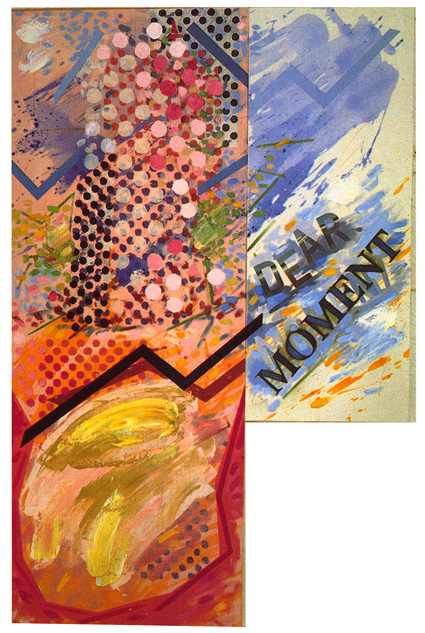 |
'Letters
to Language' 'Dear Moment' 1996
The
force of the works here is not to expose or even to reject
these dialectical prisons of the communicative universe.
In our historical condition, that is no more important than
telling us that there is light in the room. Communication
is unavoidable: to communicate and to be human are synonymous,
though communication has been transformed, over centuries,
into economy to the point that all communication has become
economic in some way. The effort has to be first to maintain
the possibility of communication through the struggle to
communicate. Here, all is delay, even more than it is lack
or loss. The letters all arrive aftei language has already
moved on, discovering in its place its traces deficit, memor\
shadow. These are the conditions of the contemporary obsession
with an impossibft instantaneity, the dream of the utterly
transparent, utterly efficient messag couched in the language
of speed. The material of communication is its inconvu nience,
in the sense that its real duration and distance demands
calm moments o otiose exploration, a return to pleasure
in the place of excitement.
 |
And then, to explore the grounds on which communication
may occur at all. In the choice of painting, Clarke chooses
silence, but in his use of letters, instigates another,
inner speech, an activity of interpretation in the very
place, at the heart of transmission, where information engineering
insists that there is neither medium nor content but pure
flow.
To instigate interpretation, with all its commonness, sociality,
misunderstanding and argument, its democracy, at the site
of the Black Box as Clarke has done is to gum up the works,
not as sabotage, but to discover whether, as the viewer
opens the box, and the monsters at their breathtaking velocities
fly out to plague us, there may be some Pandora's jewel
resting at the bottom, the slow gemstone of hope.
Sean
Cubitt is a Reader in the Department of Media and Cultural
Studies at the
Liverpool John Moores University
Acknowledgements
Thanks
to the Department of Art and Fashion, University of Central
Lancashire, Preston for support in publishing this catalogue
Thanks
to Sean Cubitt for his catalogue essay and critical practice
Thanks
to Stephen Snoddy and Cornerhouse for their help and support
Thanks
more than ever to Angie, Joe and Tom
Pete
Clarke September 1996